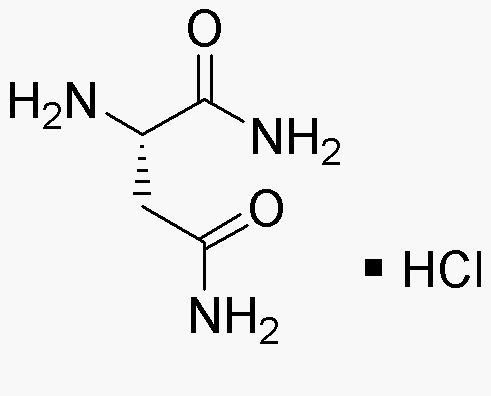L-Asparagine amide hydrochloride is widely utilized in research focused on:
- Biotechnology: It serves as a key nutrient in cell culture media, promoting the growth of various cell lines, particularly in the production of therapeutic proteins.
- Pharmaceuticals: This compound is used in drug formulation processes, enhancing the solubility and stability of active pharmaceutical ingredients.
- Neuroscience: It acts as a precursor for neurotransmitters, making it valuable in studies related to brain function and neurodegenerative diseases.
- Agriculture: It is applied in the development of biofertilizers, contributing to improved plant growth and yield by enhancing nitrogen metabolism.
- Food Industry: This chemical is utilized as a food additive, providing nutritional benefits and improving the flavor profile of certain products.
General Information
Properties
Safety and Regulations
Applications
L-Asparagine amide hydrochloride is widely utilized in research focused on:
- Biotechnology: It serves as a key nutrient in cell culture media, promoting the growth of various cell lines, particularly in the production of therapeutic proteins.
- Pharmaceuticals: This compound is used in drug formulation processes, enhancing the solubility and stability of active pharmaceutical ingredients.
- Neuroscience: It acts as a precursor for neurotransmitters, making it valuable in studies related to brain function and neurodegenerative diseases.
- Agriculture: It is applied in the development of biofertilizers, contributing to improved plant growth and yield by enhancing nitrogen metabolism.
- Food Industry: This chemical is utilized as a food additive, providing nutritional benefits and improving the flavor profile of certain products.
Documents
Safety Data Sheets (SDS)
The SDS provides comprehensive safety information on handling, storage, and disposal of the product.
Product Specification (PS)
The PS provides a comprehensive breakdown of the product’s properties, including chemical composition, physical state, purity, and storage requirements. It also details acceptable quality ranges and the product's intended applications.
Certificates of Analysis (COA)
Search for Certificates of Analysis (COA) by entering the products Lot Number. Lot and Batch Numbers can be found on a product’s label following the words ‘Lot’ or ‘Batch’.
*Catalog Number
*Lot Number
Certificates Of Origin (COO)
This COO confirms the country where the product was manufactured, and also details the materials and components used in it and whether it is derived from natural, synthetic, or other specific sources. This certificate may be required for customs, trade, and regulatory compliance.
*Catalog Number
*Lot Number
Safety Data Sheets (SDS)
The SDS provides comprehensive safety information on handling, storage, and disposal of the product.
DownloadProduct Specification (PS)
The PS provides a comprehensive breakdown of the product’s properties, including chemical composition, physical state, purity, and storage requirements. It also details acceptable quality ranges and the product's intended applications.
DownloadCertificates of Analysis (COA)
Search for Certificates of Analysis (COA) by entering the products Lot Number. Lot and Batch Numbers can be found on a product’s label following the words ‘Lot’ or ‘Batch’.
*Catalog Number
*Lot Number
Certificates Of Origin (COO)
This COO confirms the country where the product was manufactured, and also details the materials and components used in it and whether it is derived from natural, synthetic, or other specific sources. This certificate may be required for customs, trade, and regulatory compliance.


